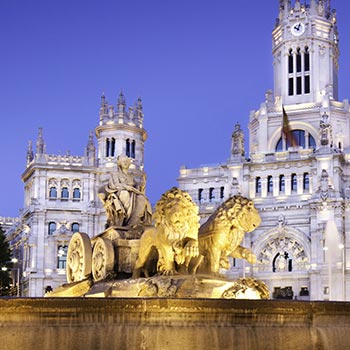Image Theory
Engineering & Social Sciences Program
Madrid, Spain
Dates: 8/28/22 - 12/23/22

Image Theory
OVERVIEW
CEA CAPA Partner Institution: Universidad Carlos III de Madrid
Location: Madrid, Spain
Primary Subject Area: Media Studies
Instruction in: English
Course Code: 13503
Transcript Source: Partner Institution
Course Details: Level 100
Recommended Semester Credits: 3
Contact Hours: 42
DESCRIPTION
1. THINKING IMAGES
1.1 Image´s materiality
1.2 Image and reality
1.3 Image and representation
1.4 Different types of images
2. BRIEF HISTORY OF THE IMAGE: FROM THE BISON TO THE DIGITAL IMAGE
2.1 Telling reality: pure mimesis?
2.2 From art to videosphere
2.3 The media's image production: photography, cinema, television
2.4 The digital environment
3. IMAGE SOCIETY: THE ICONOSPHERE
3.1 Concept of society, civilization, culture of the image
3.2 The Society of the Spectacle / Society as a show
3.3 Image: landscape or essence of the social bond?
4. PERCEPTION AS KNOWLEDGE: PERCEPTO, CULTURE AND SUBJECT
4.1 The senses as sources of knowledge
4.2 How do we perceive the images?
4.3 The cultural value of the image
4.4 The perceiving subject: the significance
5. CREATIVITY
5.1 Creativity and being creative
5.2. What makes us creative?
5.3. Indicators of creativity
5.4. How to operate in the creative process
5.5 The artist and the craftsman
6. MORPHOLOGICAL, DYNAMIC AND SCALAR ELEMENTS OF THE IMAGE
6.1 Scalar elements: point, line, plane, texture, color, shape
6.2 Dynamic Elements: stress, rhythm
6.3 Scalar Elements: size, format, scale, proportion
7. BASIC CHARACTERISTICS OF THE IMAGE
7.1 Iconicity-abstraction
7.2 Simplicity-complexity
7.3 Monosemy-polisemia
7.4 Originality-redundancy
7.5 Connotation-denotation
8. IMAGE COMPOSING
8.1 On the composition
8.2 The dynamic equilibrium
8.3 Weight and visual direction
8.4 The frame
9. STILL, SEQUENTIAL AND MOVING IMAGES
9.1 Characteristics of the still image isolated: painting and photography
9.2 the sequence: comic, fotonovela, storyboard
9.2 Characteristics of the sequential images and movies: TV and Film
10. IMAGE AS TEXT: READING OF IMAGES
10.1 What is a text?
10.2 Why the image is a text?
10.3 Are there reading routes on images?
10.4 Reading images: the artistic image, the advertising image, the image information
11. IMAGE AND EDUCATION
11.1 Generational change and knowledge flow
11.2. Logos and images
11.3. Inform, entertain, educate
11.4 Image Pedagogy and media education
12. THE BODY OF THE IMAGES, THE IMAGES OF THE BODY
12.1 The body and its representation: symbolic and ritual space
12.2 Body´s ornament
12.3 The portrait and the subject
12.4 Tattoo and other practices of marking and body modification: the tuned body
1.1 Image´s materiality
1.2 Image and reality
1.3 Image and representation
1.4 Different types of images
2. BRIEF HISTORY OF THE IMAGE: FROM THE BISON TO THE DIGITAL IMAGE
2.1 Telling reality: pure mimesis?
2.2 From art to videosphere
2.3 The media's image production: photography, cinema, television
2.4 The digital environment
3. IMAGE SOCIETY: THE ICONOSPHERE
3.1 Concept of society, civilization, culture of the image
3.2 The Society of the Spectacle / Society as a show
3.3 Image: landscape or essence of the social bond?
4. PERCEPTION AS KNOWLEDGE: PERCEPTO, CULTURE AND SUBJECT
4.1 The senses as sources of knowledge
4.2 How do we perceive the images?
4.3 The cultural value of the image
4.4 The perceiving subject: the significance
5. CREATIVITY
5.1 Creativity and being creative
5.2. What makes us creative?
5.3. Indicators of creativity
5.4. How to operate in the creative process
5.5 The artist and the craftsman
6. MORPHOLOGICAL, DYNAMIC AND SCALAR ELEMENTS OF THE IMAGE
6.1 Scalar elements: point, line, plane, texture, color, shape
6.2 Dynamic Elements: stress, rhythm
6.3 Scalar Elements: size, format, scale, proportion
7. BASIC CHARACTERISTICS OF THE IMAGE
7.1 Iconicity-abstraction
7.2 Simplicity-complexity
7.3 Monosemy-polisemia
7.4 Originality-redundancy
7.5 Connotation-denotation
8. IMAGE COMPOSING
8.1 On the composition
8.2 The dynamic equilibrium
8.3 Weight and visual direction
8.4 The frame
9. STILL, SEQUENTIAL AND MOVING IMAGES
9.1 Characteristics of the still image isolated: painting and photography
9.2 the sequence: comic, fotonovela, storyboard
9.2 Characteristics of the sequential images and movies: TV and Film
10. IMAGE AS TEXT: READING OF IMAGES
10.1 What is a text?
10.2 Why the image is a text?
10.3 Are there reading routes on images?
10.4 Reading images: the artistic image, the advertising image, the image information
11. IMAGE AND EDUCATION
11.1 Generational change and knowledge flow
11.2. Logos and images
11.3. Inform, entertain, educate
11.4 Image Pedagogy and media education
12. THE BODY OF THE IMAGES, THE IMAGES OF THE BODY
12.1 The body and its representation: symbolic and ritual space
12.2 Body´s ornament
12.3 The portrait and the subject
12.4 Tattoo and other practices of marking and body modification: the tuned body







